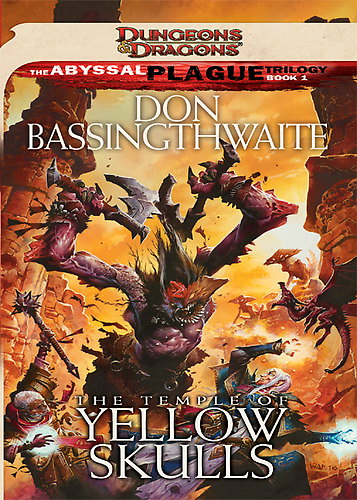
![]() Now that Dungeons & Dragons 4th edition has been out since the summer of 2008, I feel it’s turning the corner on its originally highly mechanical and gamey feel and presentation, now striving for the wise balance of game and roleplay or storytelling D&D truly is. The game has matured, the products have matured, and between us all – from designers to players and DMs – we’ve now learned that this precious balance of D&D’s core aspects is its driving force, like it is for nearly every roleplaying game.
Now that Dungeons & Dragons 4th edition has been out since the summer of 2008, I feel it’s turning the corner on its originally highly mechanical and gamey feel and presentation, now striving for the wise balance of game and roleplay or storytelling D&D truly is. The game has matured, the products have matured, and between us all – from designers to players and DMs – we’ve now learned that this precious balance of D&D’s core aspects is its driving force, like it is for nearly every roleplaying game.
Product Evidence
Look at the layout in Monster Manual 3 or Monster Vault, where monster lore, fluff, history and ecology all get plenty of attention – by far the most inspiring amount of campaign, adventure and encounter-generating ideas in any monster book we’ve seen in 4e. An emphasis on personality or instinctive traits, temperaments, motivations and relationships with other monsters is found in each creature’s entry.
This fluff also helps better interpret the attacks and statistics of each monster as well – which weren’t always easy to explain or visualize with only their name to guide you. Now ‘powers’ are more clearly similar to spells, prayers, exploits or otherwise supernatural, extraordinary or natural in nature.
Finally, Monster Vault in particular is actually pleasant to read for leisure. Because of all its detailed well-presented lore (usually around three paragraphs with a bold headline for each to give you the quick main idea of that aspect of the monster), it’s an entertaining and informative fantasy read that is a by far more balanced approach to D&D sourcebooks than the earliest core rulebooks.
How to Add Equal Parts Atmosphere
Now that Wizards is clearly on board with encouraging that fine balance of storytelling or roleplay atmosphere and game in 4e, make sure to do your part to add it to your games. It’s easy to make your D&D adventures more immersive.
For example, make sure to mention atmospheric details, such as how your mounts handle the trek through the mountains or rainstorm. Narratively describe fights or encounters they blew through without much more than a few scratches. After all, at some point, patrols of goblins, orcs or some wild animals are simply not much of a threat to the party. But a quick storytelling mention of them is worth its very light weight in gold.
Balanced Examples
You can find more examples of this balance of flavor and crunch in 4e products beyond Monster Vault and MM3.
A great example of imaginative ideas and roleplay meeting mechanics is the “Improvising with [Skill Name]” section at end of each skill in the rules Rules Compendium. You’ll find around three creative examples and ideas on how to flavorfully describe certain actions that the base skill rules don’t cover, and a suggested DC tier (easy, moderate or hard) for each.
Also in the Compendium, you’ll see weather can force Endurance checks both throughout the day and after sleeping. Driving, cold rainstorms over a few days of travel might make it tougher on the wizards and clerics, but no so much with the fighters or barbarians. This adds a balance of flavor with some mechanical impact – everything a D&D player and DM wants!
More Ideas
Just like you’d describe a horror themed campaign with details and mysterious “things” that capture that flavor, so too can you do with high and classic fantasy adventuring – or any of your D&D campaigns.
For more ideas and inspiration on all the world details and people care-abouts that make a fantasy world feel like a fantasy world, look to your favorite fantasy books, movies, shows or video games, such as the widely acclaimed Dragon Age and its freshly released sequel Dragon Age II. D&D world-specific novels are particularly nice for ideas on these little world details – for example, I’m reading Temple of Yellow Skulls right now, and one of the things I’m enjoying is getting the author’s fleshed-out take on some of Fallcrest‘s people and places.
Continue to challenge yourself to find ways to seemlessly blend 4e’s robust mechanics with the classic atmospheric wonder of D&D! Like with world creation or character creation – start small. It’s much easier than you think to sprinkle in tiny bits of flavor to balance out the gamespeak.
Have even more simple suggestions for or elegant examples of the balance of game and roleplay? Share your thoughts here.
[…] (besides being a true pleasure to read with its fantastic attention to flavor, similar to the recent shift in books like Monster Vault and MM3) basically gave fighter-types a full nine levels worth of […]
[…] it’s been three years now, and much like MM3 and Monster Vault started turning the corner on balancing in more story in 4e, I feel as though we’re starting to turn that corner on […]